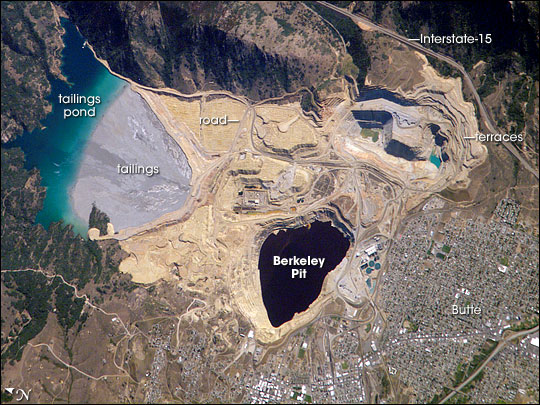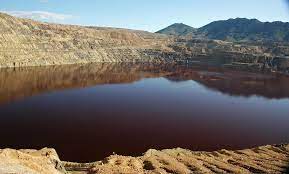
Southwest of Montana at almost two thousand feet deep, Berkeley Pit gleams menacingly at those who dare approach. Heavily acidic waters fill up approximately 900 feet of the Pit and the brown shine of the water reveals the inherent danger it presents. It has killed more than three thousand snow geese from exposure to its acidic metals, and it endangers the groundwater tables for local towns. This former open-pit copper mine in Montana is a lethal cesspool of toxicity. How did it reach this point? To truly explain this ecological disaster, we first need to explain the effects mining can have on soil health and the purity of water.
Mining is an important industry. Many of our most prized possessions and technologies are only possible due to mining the earth for precious raw metals and minerals. The metals in our phones, the materials in our buildings, the fuels we use for energy such as coal or oil; all of these are obtained through mining. Steel, which is composed of a mixture of iron and other elements, is essential for buildings, machinery, and vehicles. Copper, for example, conducts electricity well and is used in electrical wiring.1 Without mining, our world would be significantly more primitive. In the United States, mining provides more than 500,000 jobs directly related to the industry, and indirectly, an additional 1.8 million jobs to those in the engineering and manufacturing industries who utilize the products in their creations.2 Clearly, mining is crucial in our modern society and without it, our world would be much more underdeveloped.
However, despite these significant contributions from the mining industry, the current style of mining is harmful to our environment in a variety of ways, including the toxic pollution of soil and water. Because desired resources are typically present as only a few percent of the total volume of a mineral deposit, mining produces significant amounts of waste material that are often not disposed of properly (See Figure 1). Waste material, or gangue, refers to mineralized rocks that do not have high enough concentrations of profitable minerals. It is more cost-effective to simply dispose of these materials at or near the surface, rather than to extract the minerals within. Exposed to the atmosphere, natural chemical processes affect these waste materials and they can begin to release toxic compounds for long periods of time, even after the mine responsible for them has closed.3 Thus, one needs to consider how these disposed materials could possibly affect the surrounding ecosystem in the long-term, as well as design possible solutions to combat these adverse conditions.

Additionally, researchers also employ geoenvironmental models, which anticipate possible chemical and physical weathering (the surface and near-surface processes during which rocks break down) and determine the baseline conditions before the mining can begin.6 These different types of studies are useful because they determine whether the interactions between resources and the landscape associated with a mine are forcing unhealthy amounts of pressure on an environment, aiding scientists in determining the overall impact from mining on the ecosystem.7
One of the largest mining sites in the world is located near Dingnan County in the Jiangxi province of China. Researchers there have collected samples of soil and water to analyze them and compared the concentration of rare earth elements in such mining sites to control sites (such as streams and soils with little access to mines). One of their discoveries was that the total concentration of rare earth elements in stream water samples in this mining site were “hundreds to thousands times higher than the world’s freshwater”.8 Similarly, the average concentration of these elements in sediments and farmland soil was several times higher than background levels in the control sites.
The researchers warned that such high concentrations may cause “environmental and health damages”, and that further studies needed to be conducted to determine how bad the risks are for such environments.9 In addition to rare earth elements, one compound that demonstrated higher concentrations in the streams affected by mining was sulfate. These sulfur-bearing ionic molecules can increase the acidity of an environment, and may lead to incidences of acid rain. The researchers discovered that ecosystems near mining sites have a high concentration of these rare elements in comparison. Strong soil weathering and leaching were evidenced as well, which means that these elements can spread to other water sources.10
These types of mining impacts from mining are not limited to these Chinese mines. Around the world, elements from mining sites are spread through waste material leaching into the ground and water systems. Chemical weathering dissolves the materials and makes it easy for residual amounts of potentially toxic materials to spread to surrounding rivers and agricultural soils. It is particularly troublesome and dangerous in the case of water sources as water is constantly flowing and may spread through much farther distances.11 “Water may interact with disturbed mineralized material, absorbing heavy metals and changing pH levels, before flowing into other water sources”.12 Contaminated water and soils are incapable of producing healthy food, endangering the local communities near mining sites as well as the local wildlife. Elements in polluted water may increase the chances of suffering from different types of cancers, cardiovascular and/or neurological disease.13 Long-term exposure (such as in food or water) to rare earth elements may also cause different mental illnesses and increase bone cancer rates in people.14
This brings the story back to Berkeley Pit in Butte, Montana, an open-pit copper mine that operated from 1955 to 1982. Open-pit mining refers to a style of mining where the miners extract minerals and rock by blasting soil and vegetation to access the underground layers of ore, creating a large pit in the ground. The techniques involved in this style of mining produce significant amounts of waste rock, and due to the deep burrowing into the ground, may cause interference with groundwater.15 This is exactly what occurred at Berkeley Pit. When the mining operations were active, groundwater had been purposefully pumped away from the mine in order to prevent contamination. However, after it closed down, the mining company in charge of this stopped the continued pumping, and groundwater rose and seeped into the mineral-laced soil and rock of the mine (Figure 2).

To prevent such further damage to the ecosystem at Berkeley Pit, which lies incredibly close to the town of Butte (See Figure 3), the EPA decreed the area in need of significant water treatment. A water treatment plant was built, and is currently treating the toxic water on sites, purifying and sampling it to ensure it meets safety regulations. Afterward, the now clean water will be sent to local creeks. Although this water treatment is of tremendous help, the Berkeley Pit contains approximately 50 billion gallons of this metal-rich water, and it will take many years before the ecosystem can be considered rehabilitated.19

Another aspect in reducing the contamination of soils and waters is in implementing newer, cleaner mining technologies. Modern cleaner technologies (such as those used for detoxification purposes) release fewer pollutants than traditional mining, and may decrease environmental damage caused at mines in the long term. Many mines rely on traditional technologies that are not as environmentally friendly because they are cheaper and result in profit for the company more quickly. They ignore the great cost that occurs in reclaiming polluted lands and treating contaminated sources of water and soil. However, as priorities shift towards increased social awareness and more sustainable practices in the management of mining companies, it is possible to significantly reduce environmental contamination at the source.22
Similarly to the reasons why older dirtier technology is still used in mining operations, there is a lack of funding, and enforcement of environmental policies is prevalent in many countries. For example, Tanzania, one of Africa’s largest mining countries, views mining largely as an economic issue, not an environmental one. Environmental policies are underdeveloped and unenforced, causing the country to experience significant amounts of pollution due to mining. Scientists in Tanzania conducted various interviews in 2020 regarding the legal framework in regards to mining and 75% of the interviewees claimed that it was “inadequate”.23 The researchers concluded that improved environmental policies, regulations, and enforcement are needed to enact crucial changes in preventing the contamination of soil and water due to mines.
It is unrealistic to expect an end to all mining endeavors at once. The mineral extraction industry provides so many of the materials people need in their lives, and it would require human society to make life-changing decisions to ever stop mining. Instead, the mining industries should be modified so that alongside their economic priorities, environmental policies are mandated and enforced, in order to obtain the metals and materials human society needs while preventing as much harm as possible to our dear planet. The consequences of failing in this duty include the contamination of our ecosystems, poisoning our wildlife through our soils and water sources, and expanding the rates at which diseases claim human lives.
- Miller, G. Tyler, and Scott Spoolman. “Geology and Nonrenewable Mineral Resources.” Chapter. In Environmental Science, 16th ed. Cengage, 2019. ↵
- Office of Energy Efficiency and Renewable Energy. “Mining Industry Profile.” Energy.gov. US Department of Energy, 2021. https://www.energy.gov/eere/amo/mining-industry-profile. ↵
- Jordan, Gyozo, and Ahmed Abdaal. “Decision Support Methods for the Environmental Assessment of Contamination at Mining Sites.” Environmental Monitoring and Assessment. Springer Netherlands, March 2, 2013. https://link.springer.com/article/10.1007/s10661-013-3137-z. doi:10.1016/B978-008045405-4.00627-3. ↵
- John, James St. 2010. English: The Grayish, Terraced Wall in the Background Is the Continental Mine (= Continental Pit) in Butte, Montana, as Seen from the Yankee Doodle Tailings Pond. The Town Is Known as the “Richest Hill on Earth” and “The Mining City”. The Butte Mining District Has Produced Gold, Silver, Copper, Molybdenum, Manganese, and Other Metals. Creative Commons Attribution 2.0 Generic license. https://www.flickr.com/photos/47445767@N05/50973974367/. https://commons.wikimedia.org/wiki/File:Continental_Mine_%26_waste_rock_pile_(Butte,_Montana,_USA)_2.jpg. ↵
- Jordan, Gyozo, and Ahmed Abdaal. “Decision Support Methods for the Environmental Assessment of Contamination at Mining Sites.” Environmental Monitoring and Assessment. Springer Netherlands, March 2, 2013. https://link.springer.com/article/10.1007/s10661-013-3137-z. doi:10.1016/B978-008045405-4.00627-3. ↵
- Jordan, Gyozo, and Ahmed Abdaal. “Decision Support Methods for the Environmental Assessment of Contamination at Mining Sites.” Environmental Monitoring and Assessment. Springer Netherlands, March 2, 2013. https://link.springer.com/article/10.1007/s10661-013-3137-z. doi:10.1016/B978-008045405-4.00627-3. ↵
- Jordan, Gyozo, and Ahmed Abdaal. “Decision Support Methods for the Environmental Assessment of Contamination at Mining Sites.” Environmental Monitoring and Assessment. Springer Netherlands, March 2, 2013. https://link.springer.com/article/10.1007/s10661-013-3137-z. doi:10.1016/B978-008045405-4.00627-3. ↵
- Liu, Wen-Shen, Mei-Na Guo, Chang Liu, et al. “Water, Sediment and Agricultural Soil Contamination from an Ion-Adsorption Rare Earth Mining Area.” Chemosphere, Volume 216, February 2019, Pages 75-83, https://www.sciencedirect.com/science/article/pii/S0045653518319702. https://doi.org/10.1016/j.chemosphere.2018.10.109. ↵
- Liu, Wen-Shen, Mei-Na Guo, Chang Liu, et al. “Water, Sediment and Agricultural Soil Contamination from an Ion-Adsorption Rare Earth Mining Area.” Chemosphere, Volume 216, February 2019, Pages 75-83, https://www.sciencedirect.com/science/article/pii/S0045653518319702. https://doi.org/10.1016/j.chemosphere.2018.10.109. ↵
- Liu, Wen-Shen, Mei-Na Guo, Chang Liu, et al. “Water, Sediment and Agricultural Soil Contamination from an Ion-Adsorption Rare Earth Mining Area.” Chemosphere, Volume 216, February 2019, Pages 75-83, https://www.sciencedirect.com/science/article/pii/S0045653518319702. https://doi.org/10.1016/j.chemosphere.2018.10.109. ↵
- Angelovičová, L., and D. Fazekašová. “Contamination of the Soil and Water Environment by Heavy Metals in the Former Mining Area of Rudňany (Slovakia).” Soil and Water Research 9, no. No. 1 (January 23, 2014): 18–24. https://doi.org/10.17221/24/2013-SWR. ↵
- Kinyondo, Abel, and Chris Huggins. “State-Led Efforts to Reduce Environmental Impacts of Artisanal and Small-Scale Mining in Tanzania: Implications for Fulfilment of the Sustainable Development Goals.” Environmental Science & Policy 120 (June 1, 2021): 157–64. https://doi.org/10.1016/j.envsci.2021.02.017. ↵
- Angelovičová, L., and D. Fazekašová. “Contamination of the Soil and Water Environment by Heavy Metals in the Former Mining Area of Rudňany (Slovakia).” Soil and Water Research 9, no. No. 1 (January 23, 2014): 18–24. https://doi.org/10.17221/24/2013-SWR. ↵
- Liu, Wen-Shen, Mei-Na Guo, Chang Liu, et al. “Water, Sediment and Agricultural Soil Contamination from an Ion-Adsorption Rare Earth Mining Area.” Chemosphere, Volume 216, February 2019, Pages 75-83, https://www.sciencedirect.com/science/article/pii/S0045653518319702. https://doi.org/10.1016/j.chemosphere.2018.10.109. ↵
- Park, Jonghoon, Eunhye Kwon, Euijin Chung, Ha Kim, Batbold Battogtokh, and Nam C. Woo 2020. “Environmental Sustainability of Open-Pit Coal Mining Practices at Baganuur, Mongolia” Sustainability 12, no. 1: 248. https://doi.org/10.3390/su12010248. ↵
- John, James St. 2010. English: The Town of Butte, Montana (Pronounced “Byoot”) Is Known as the “Richest Hill on Earth” and “The Mining City”. The Butte Mining District Has Produced Gold, Silver, Copper, Molybdenum, Manganese, and Other Metals. Creative Commons Attribution 2.0 Generic license. https://www.flickr.com/photos/47445767@N05/50869213686/. https://commons.wikimedia.org/wiki/File:Berkeley_Pit_(Butte,_Montana,_USA)_35.jpg. ↵
- Leech, Brian. “Boom, Bust, and the Berkeley Pit: How Insiders and Outsiders Viewed the Mining Landscape of Butte, Montana.” IA. The Journal of the Society for Industrial Archeology 37, no. 1/2 (2011): 161. http://www.jstor.org/stable/23757914. ↵
- “Thousands of Snow Geese Die in Montana after Landing on Contaminated Water.” The Guardian. Guardian News and Media, December 7, 2016. https://www.theguardian.com/us-news/2016/dec/07/thousands-of-snow-geese-die-in-montana-after-landing-on-contaminated-water?CMP=share_btn_fb. ↵
- Saks, Nora. “Butte Reaches Superfund Milestone, Releasing Berkeley Pit Water into Silver Bow Creek.” Montana Public Radio. Montana Public Radio, October 1, 2019. https://www.mtpr.org/montana-news/2019-10-01/butte-reaches-superfund-milestone-releasing-berkeley-pit-water-into-silver-bow-creek. ↵
- “Berkeley Pit: Butte, Montana.” 2006. Text.Article. NASA Earth Observatory. November 13, 2006. https://earthobservatory.nasa.gov/images/7108/berkeley-pit-butte-montana. ↵
- Hilson, Gavin, and Barbara Murck. “Sustainable Development in the Mining Industry: Clarifying the Corporate Perspective.” Resources Policy 26, no. 4 (December 1, 2000): 227–38. https://doi.org/10.1016/S0301-4207(00)00041-6 ↵
- Hilson, Gavin, and Barbara Murck. “Sustainable Development in the Mining Industry: Clarifying the Corporate Perspective.” Resources Policy 26, no. 4 (December 1, 2000): 227–38. https://doi.org/10.1016/S0301-4207(00)00041-6 ↵
- Kinyondo, Abel, and Chris Huggins. “State-Led Efforts to Reduce Environmental Impacts of Artisanal and Small-Scale Mining in Tanzania: Implications for Fulfilment of the Sustainable Development Goals.” Environmental Science & Policy 120 (June 1, 2021): 157–64. https://doi.org/10.1016/j.envsci.2021.02.017. ↵


25 comments
Carolina Wieman
Mining is one of the many ways we are able to extract our precious metals. Copper as the author explained is one of the many essential minerals that help to support our population. Copper helps to conduct electricity which is needed for our growing electronic world. This is just one of many minerals we readily extract to maintain a lifestyle we have become accustomed to. As much as we want to continue to support this life the repercussions of mining are extremely detrimental to the environment. Waste material, mudslides, and loss of habitats are just a few of the major effects that mining has on the environment. If we continue to proceed down this road the effects may become irreversible. As we find alternative ways to support our energy and other important needs we may still have a chance to salvage what we have though once lost.
Joshua Marroquin
First of all, I want to say this was a perfect example of how humans do more harm to the earth then they believe they do. It is crazy how much damage can be done just by a group of people mining for resources. It is crazy to find out how much a negative impact that mining can cause to the surrounding environment.
Quianna Wynn
Its very interesting to see that although mining from the earths materials provide very important materials to our everyday lives, it also has many harmful parts to it, and as we explore more and research more we find that we may be doing more harm than good. I never really payed attention to what mining did for us in depth, but this gives me a reality check ion how impactful mining is and how can be both a benefit and a harm to us and those mining.
Sara Davila
I really enjoyed reading any articles that have to do with biology and the environment. The world we live in today is 2the only one we have; therefore, it is important that society takes care of it so that future generations can also witness its beauty. I love how the article urges its readers to consider this after learning the damages of mining. I have learned numerous new ideas after reading and overall was well written.
Hoa Vo
Thank you for providing this informative article about mining affects the natural environment. I always acknowledge that most human activities lead to huge damage to natural habitats just to serve human needs. However, this information gives me a broad view of how the mining industry poison the environment and different effects on the pools, land, animals. Hopefully that in the future the government gives an effective solution for this manner before it is too late.
HOA VO
Thank you for providing this informative article about mining affects the natural environment. I always acknowledge that most human activities lead to huge damage to natural habitats just to serve human needs. However, this information gives me a broad view of how the mining industry poison the environment and different effects on the pools, land, animals. Hopefully that in the future the government give effective solution for this manner before it is too late.
Andrew Ponce
The way this article portrays the importance of the environment is extremely well rounded. The author explained the issues with mining and and its effects on the planet, not only with precisiveness, but with clarity. Topics like this are very important to cover and share with others, especially in a time where climate change is such a large topic. Overall amazing article with great information to take with you everywhere.
Alex Trevino
I had no idea of the dangers mining services posed to the environment before this. The environmental impacts of outdated mining techniques are something I have never thought of and are something that more people should be concerned about. The damages that this poses, and the work we can do to help spread the word about these issues are just as, if not more important than other topics such as deforestation and climate change. I am incredibly glad that this is something that someone is working to spread the word about and am really impressed at the work put into this, excellent work.
Ruben Becerril
I have never really considered the outcomes of mining on the environment which has broadened my view on the subject. I was able to easily understand the different effects it leads to such as poisoning the water, habitat loss, etc. This makes me wonder if mining is even worth it and what steps can be taken to prevent further destruction of the environment.
Kanum Parker
This article does a great job of examining the mining industry what effects it has on the world. We are the only animals that mine and look for material meaning mining is very unnatural. It maybe important to us and our society but by mining we caused a lot of damage that is going to take us forever to fix. We need that water and soil to survive and so does other animals. The environment is every important so it’s good that we are finding ways to make it a cleaner and better process.